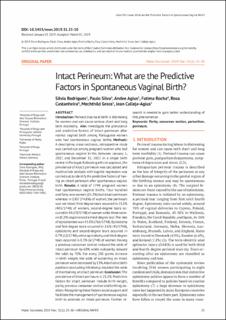Please use this identifier to cite or link to this item:
https://doi.org/10.21256/zhaw-19231Full metadata record
| DC Field | Value | Language |
|---|---|---|
| dc.contributor.author | Rodrigues, Silvia | - |
| dc.contributor.author | Silva, Paulo | - |
| dc.contributor.author | Agius, Andee | - |
| dc.contributor.author | Rocha, Fatima | - |
| dc.contributor.author | Castanheira, Rosa | - |
| dc.contributor.author | Gross, Mechthild Maria | - |
| dc.contributor.author | Calleja-Agius, Jean | - |
| dc.date.accessioned | 2020-01-29T09:56:53Z | - |
| dc.date.available | 2020-01-29T09:56:53Z | - |
| dc.date.issued | 2019 | - |
| dc.identifier.issn | 1512-7680 | de_CH |
| dc.identifier.uri | https://digitalcollection.zhaw.ch/handle/11475/19231 | - |
| dc.description.abstract | Introduction: Perineal trauma at birth is distressing for women and can cause serious short and long term morbidity. Aim: Investigate the prevalence and predictive factors of intact perineum after normal vaginal birth among Portuguese women who had spontaneous vaginal births. Methods: A descriptive, cross-sectional, retrospective study was carried out among pregnant women who had spontaneous vaginal births, between January 1, 2017, and December 31, 2017, in a single birth centre in Portugal. Following ethical approval, the prevalence of intact perineum was calculated and multivariate analysis with logistic regression was carried out, to identify the predictive factors of having an intact perineum after spontaneous vaginal birth. Results: A total of 1748 pregnant women had spontaneous vaginal births. Four hundred and forty-one women (25.2%) had intact perineum whereas in 1307 (74.8%) of women, the perineum was not intact. First-degree tears occurred in 23.2% (405/1748) of women, second-degree tears occurred in 4% (70/1748) of women while three women (0.2%) experienced a third-degree tear. The rate of episiotomies was 43.8% (766/1748). Episiotomy and first-degree tears occurred in 2.6% (45/1748), episiotomy and second-degree tears occurred in 0.7% (12/1748), while episiotomy and third-degree tears occurred in 0.3% (6/1748) of women. Having a previous caesarean section reduced the odds of intact perineum by 60%, while nulliparity reduced the odds by 70%. For every 250 grams increase in birth weight, the odds of sustaining an intact perineum were decreased by 13%. Alternative birth positions (excluding lithotomy) doubled the odds of maintaining an intact perineum. Conclusion: The prevalence of intact perineum is 25,2%. Predictive factors for intact perineum include birth weight, parity, previous caesarean section and birthing position. Recognizing these factors could support and facilitate the management of spontaneous vaginal birth to promote an intact perineum. Further research is needed to gain better understanding of this phenomenon. | de_CH |
| dc.language.iso | en | de_CH |
| dc.publisher | Academy of Health Sciences of Bosnia and Herzegovina | de_CH |
| dc.relation.ispartof | Materia Socio-Medica | de_CH |
| dc.rights | http://creativecommons.org/licenses/by-nc/4.0/ | de_CH |
| dc.subject | Parity | de_CH |
| dc.subject | Caesarean section | de_CH |
| dc.subject | Parturition | de_CH |
| dc.subject | Perineum | de_CH |
| dc.subject.ddc | 618.4: Geburt | de_CH |
| dc.title | Intact perineum : what are the predictive factors in spontaneous vaginal birth? | de_CH |
| dc.type | Beitrag in wissenschaftlicher Zeitschrift | de_CH |
| dcterms.type | Text | de_CH |
| zhaw.departement | Gesundheit | de_CH |
| zhaw.organisationalunit | Institut für Hebammenwissenschaft und reproduktive Gesundheit (IHG) | de_CH |
| dc.identifier.doi | 10.5455/msm.2019.31.25-30 | de_CH |
| dc.identifier.doi | 10.21256/zhaw-19231 | - |
| dc.identifier.pmid | 31213951 | de_CH |
| zhaw.funding.eu | No | de_CH |
| zhaw.issue | 1 | de_CH |
| zhaw.originated.zhaw | Yes | de_CH |
| zhaw.pages.end | 30 | de_CH |
| zhaw.pages.start | 25 | de_CH |
| zhaw.publication.status | publishedVersion | de_CH |
| zhaw.volume | 31 | de_CH |
| zhaw.publication.review | Peer review (Publikation) | de_CH |
| zhaw.author.additional | No | de_CH |
| Appears in collections: | Publikationen Gesundheit | |
Files in This Item:
| File | Description | Size | Format | |
|---|---|---|---|---|
| Gross_et_al_2019_Intact_Perineum.pdf | 742.56 kB | Adobe PDF |  View/Open |
Show simple item record
Rodrigues, S., Silva, P., Agius, A., Rocha, F., Castanheira, R., Gross, M. M., & Calleja-Agius, J. (2019). Intact perineum : what are the predictive factors in spontaneous vaginal birth? Materia Socio-Medica, 31(1), 25–30. https://doi.org/10.5455/msm.2019.31.25-30
Rodrigues, S. et al. (2019) ‘Intact perineum : what are the predictive factors in spontaneous vaginal birth?’, Materia Socio-Medica, 31(1), pp. 25–30. Available at: https://doi.org/10.5455/msm.2019.31.25-30.
S. Rodrigues et al., “Intact perineum : what are the predictive factors in spontaneous vaginal birth?,” Materia Socio-Medica, vol. 31, no. 1, pp. 25–30, 2019, doi: 10.5455/msm.2019.31.25-30.
RODRIGUES, Silvia, Paulo SILVA, Andee AGIUS, Fatima ROCHA, Rosa CASTANHEIRA, Mechthild Maria GROSS und Jean CALLEJA-AGIUS, 2019. Intact perineum : what are the predictive factors in spontaneous vaginal birth? Materia Socio-Medica. 2019. Bd. 31, Nr. 1, S. 25–30. DOI 10.5455/msm.2019.31.25-30
Rodrigues, Silvia, Paulo Silva, Andee Agius, Fatima Rocha, Rosa Castanheira, Mechthild Maria Gross, and Jean Calleja-Agius. 2019. “Intact Perineum : What Are the Predictive Factors in Spontaneous Vaginal Birth?” Materia Socio-Medica 31 (1): 25–30. https://doi.org/10.5455/msm.2019.31.25-30.
Rodrigues, Silvia, et al. “Intact Perineum : What Are the Predictive Factors in Spontaneous Vaginal Birth?” Materia Socio-Medica, vol. 31, no. 1, 2019, pp. 25–30, https://doi.org/10.5455/msm.2019.31.25-30.
Items in DSpace are protected by copyright, with all rights reserved, unless otherwise indicated.